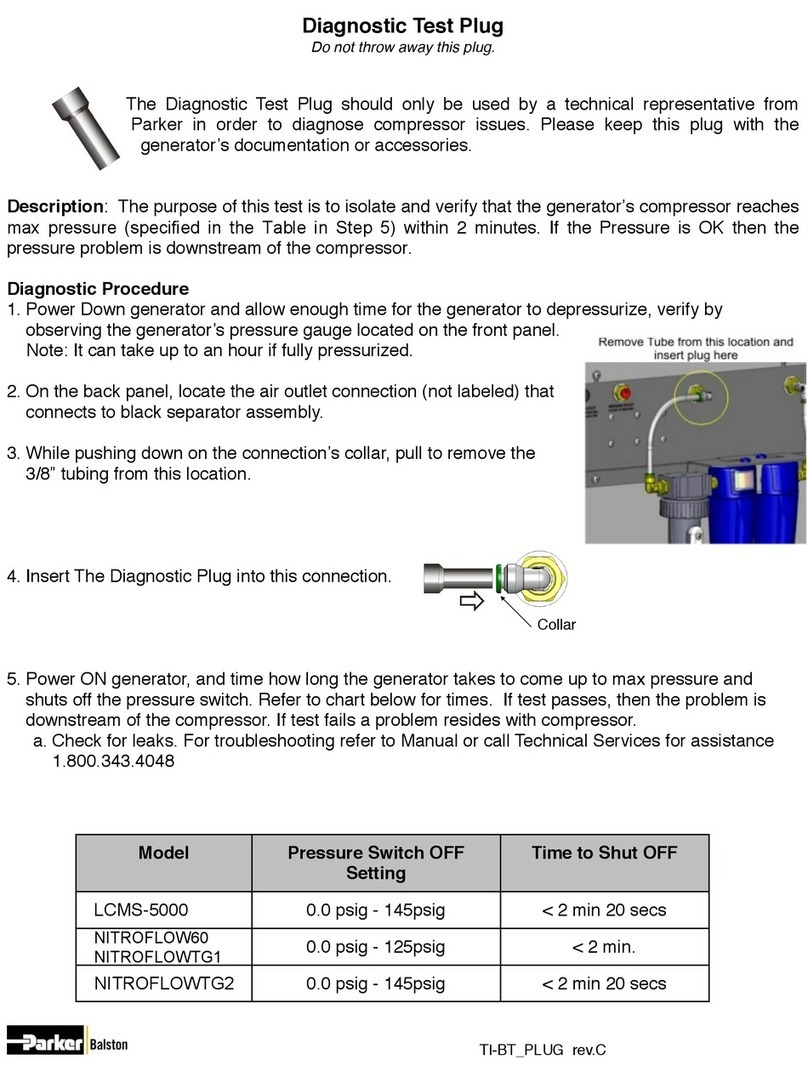
Bulletin TI-FID1000J Installation, Operation and Maintenance Manual
Technical Information FID1000 and 2500 Gas Stations
www.labgasgenerators.com
5
Note: All installation, operation and maintenance activities for the FID Gas Stations should be
performed by suitable personnel using reasonable care.
The FID 1000 and FID 2500 generators are a free-standing bench-top unit. Do not suspend the
generator from the wall or ceiling. The weight and size could pose a falling hazard. The generator
should be located indoors, protected from severe weather conditions and free from excessive ambient,
dust or dirt. Do not install the generator outdoors.
The ambient temperature of the air surrounding the generator must be between 60°F-100°F (16°C-
40°C ). Do not place the generator where there is a chance of freezing. Place the generator in an
upright position, on a level surface, in close proximity to the electrical power supply and the equipment
requiring both hydrogen and hydrocarbon-free air.
The Zero Air Generator compressed air inlet port is brass 1/4" female NPT. The inlet port is located
at the top center of the generator. The Zero Air outlet port is brass 1/8" compression union, located
below the Inlet port. Male 1/4" NPT compressed air inlet pipe ttings rated for 125 psig (8.5 Barg) line
pressure should be used to connect to the generator. The Hydrogen vent is also a brass 1/4" female
NPT, located at the right hand side of the generator and the Hydrogen outlet is a SS 1/ 8" Com-
pression Union, located directly below the hydrogen vent.
A shut-off valve and a pressure regulator should be installed directly upstream from the Parker Balston
FID Gas Station. The shut-off valve isolates the unit from the air line for maintenance and trouble-
shooting tasks. The pressure regulator controls the inlet air pressure and should be set to maintain a
constant pressure between 40 psig and 125 psig (2.7 barg and 8.5 barg ). Maintaining a constant inlet
air pressure will minimize system pressure uctuations which may affect the purity of the zero grade air.
Parker offers a pressure regulator, complete with a pressure gauge, as an accessory
(P/N 72-130-V883).
The FID 1000 and FID 2500 Gas Stations should be located in close proximity to the electrical power
supply, and the downstream equipment to which it supplies both Hydrogen and Zero grade air. There is
no limit to the distance between the generator and the point of use as long as tubing size, cleanliness,
and pressure drop are taken into consideration. The generator should be located indoors, protected
from severe weather conditions. The installation location should be free from excessive ambient dust
or dirt. Do not install the generator outdoors. The ambient temperature of the air surrounding the
generator must be between 60°F to 100°F (16°C to 40°C) to ensure optimal operation of the unit.
See page 20 for a list of the symbols displayed on the generator and referred to in this Manual.
The FID 1000 and FID 2500 generator weigh 53 lbs (24 kg). Use proper equipment and lifting tech-
niques for transporting this equipment to its installation location. The FID/Hydrogen is intended to
remain stationary when lled with water. If necessary, the generator may be transported over short dis-
tances when lled. Do not grasp the front panel Bezel when moving the generator; lift only from
the bottom. Keep the generator in an upright position.
Remove all red tape from the top cover, the back panel, and any other surfaces. Open the top cover of
the FID Gas Station. Unscrew the desiccant cartridge cap (see Figure 6). Remove the red caps/tape
sealing the back panel outlet ttings.
Do not attempt to remove desiccant cap until generator pressure reads 0 psig.
Desiccant - Wipe any drops of moisture with a lint free cloth or paper towel from the desiccant cap and
housing. Remove the desiccant cartridge from the sealed bag. Use a drop of deionized water to wet the
o-rings. Insert the cartridge into the housing, nipple end rst (see Figures 4, 5,6, and 7). Firmly push
down on the cartridge to create a hydrogen-tight seal at the bottom of the housing, making sure the
cartridge is seated.
Before replacing the desiccant cartridge cap, make sure the large Viton o-ring is centered inside the cap
(see Figure 7). Screw the cap on and tighten securely by hand. Make sure that the o-ring is centered
and that the o-ring has created a dark ringed seal.
Note: Most leaks occur due to improper sealing of the cap to the housing on the desiccant cartridge.
Preparation
Installation and Operation
General
Location
Symbols
Transporting





























